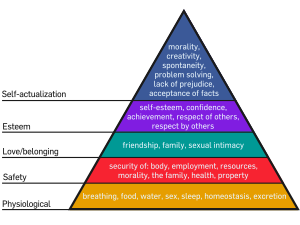THEORIES OF MOTIVATION
There are several important theories of motivation. The most widely known is that of Abraham Maslow (1908-1970). Maslow's theory (seen below) proposes that humans have five different sets of needs and that each set of needs must be realized or attained before an individual can begin to work towards the fulfilment of the next set of needs. The needs are arranged in a pyramid shape beginning with the basic needs on the bottom level. Maslow believed that humans must satisfy their basic needs for food, water, air, shelter, and other physiological needs before they can devote any time or energy to the process of attaining safety, which is the next level of the pyramid. After an individual has achieved his physiological and safety needs, then he can ascend to the next level which is love and belonging. Loving others and being loved by others is a very important source of motivation for humans and may even result in a person trying to change themselves in appearance or behavior to achieve that need for belonging. This is frequently seen in adolescents who have a strong desire to "fit in" with others their age, but is not so crucial to individuals who are older (Ormrod, 2008). The next level in Maslow's heirarchy is the quest for esteem. Esteem needs are characterized by two different types: self-esteem, which is intrinsic and is how we feel about ourselves and may be low or high, and need for esteem from others, which is the desire to have other people feel good feelings about ourselves. When an individual feels positive about themselves and feels that others percieve them in a similar way, then our esteem needs have been met and we can begin to strive for the top of the hierarchy of needs: self-actualization. Self-actualization is the state where one's other needs are satisfied and therefore the person is able to devote their time and energy to higher achievements, or be all that they can be (Ormrod. 2008). An individual in the self-actualization phase of their life may devote themselves to a cause they deem worthy in a universal sense, such as saving whales or working for world peace.
The first four needs in Maslow's Hierarchy are referred to by Maslow himself as deficiency needs meaning that they result from things people find lacking in their lives and thus must fill in order to succeed. The need for self-actualization, however, he termed as a growth need due to the fact that it is not a deficiency that must be addressed, but rather an opportunity for growth and developement whuch can be attained through desire of the individual. He estimated that < 1% of humans acheive the highest level and then almost always in their later lives (Ormrod, 2008). He loosely defined the ultimate level as the full use and exploitation of talents, capacities, potentialities, etc (Maslow, 1968).

The ERG (Existence Relatedness and Growth) Theory was designed by Clayton Alderfer. The ERG theory is very similar to Maslow's hierarchy of needs but it only has three levels where Maslow's theory consists of five. The first level of ERG theory addresses existence, the need to stay alive and safe. We are now interested in relationships with other people and what they think of us which is termed the relatedness need. Relatedness means we feel like we belong and are important members of a group. At the highest level, growth, we seek growth and developement in emotional, creative, and spiritual avenues. In other words, we become fulfilled and are functioning at our highest level of potential (Alderfer, 1972). Though the two theories may sound alike, there are several important differences between them. Alderfer's ERG theory is not as restrictive as Maslow's in that an individual can pursue different levels at the same time where Maslow proposed that people must satisfy the requirements of each level before they can progress to the next. Also, the ERG theory allows for individual differences in the order in which people attempt the completion of the levels and ERG theory also acknowledges that sometimes people must revert to an previously fulfilled level as their circumstances and desires change (Alderfer, 1972).
References
Maslow, Abraham H. (1968). Toward a Psychology of Being. Van
Nostrand, Princeton, N.J. Retrieved from http://www.abraham-mslow.com/amIndex.asp
Alderfer, C. (1972). Existence, relatedness, & growth. New York: Free Press.
No comments:
Post a Comment